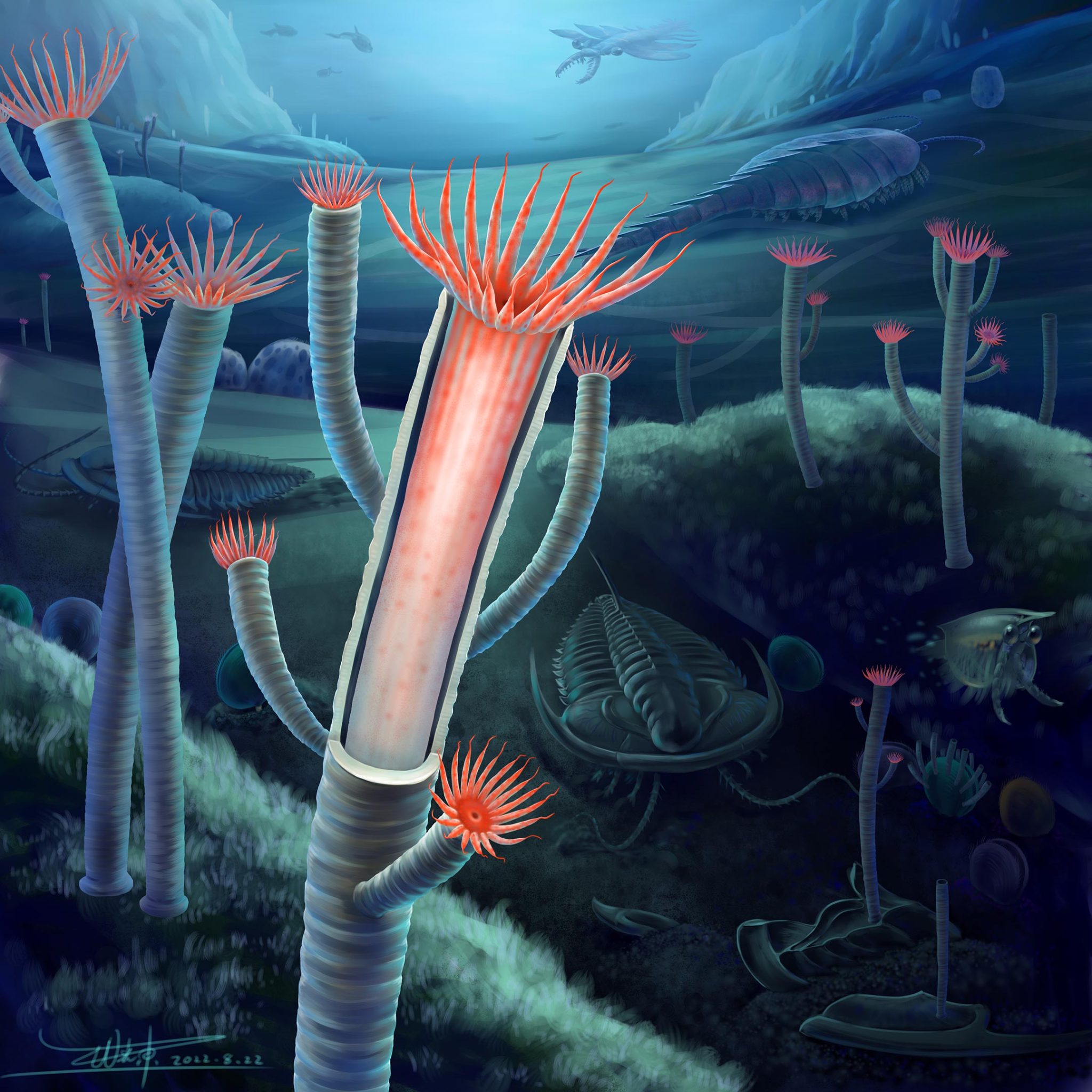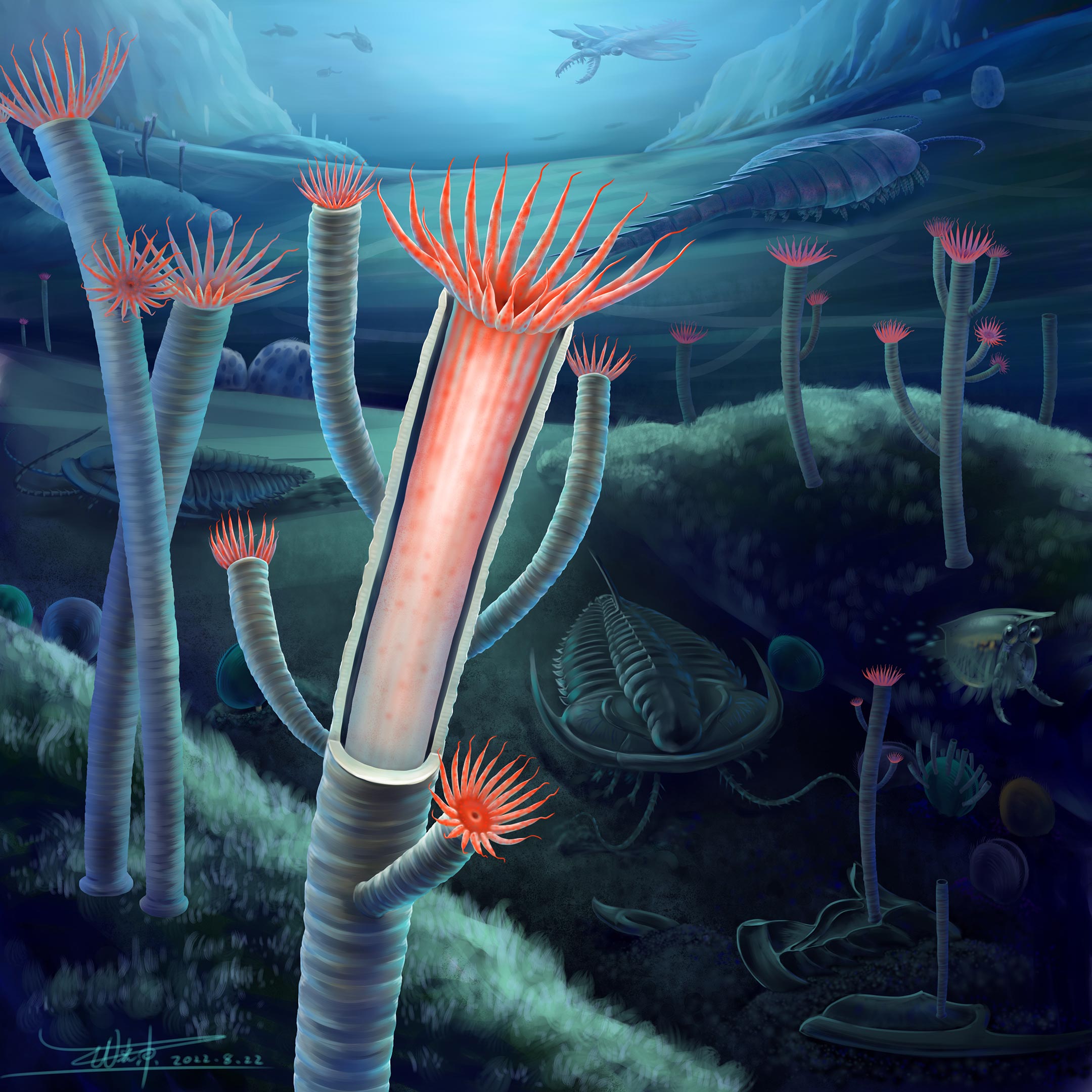
약 5억 1,400만 년 전 캄브리아기 해저에서 실제로 나타났을 강투쿠니아 아스페라의 재건. 전경에 있는 개인의 골격 일부를 제거하여 골격 내의 부드러운 종양을 보여줍니다. 크레딧: Xiaodong Wang의 재건
과학자들은 마침내 지구 생명체의 진화에 관한 수백 년 된 미스터리를 풀 수 있었고 해골을 만든 최초의 동물이 어떻게 생겼는지 밝힐 수 있었습니다. 이 발견은 중국 윈난성 동부에서 발견된 매우 잘 보존된 화석 컬렉션 덕분에 가능했습니다. 연구 결과는 과학저널 11월 2일자에 게재됐다. 왕립 학회 B의 절차.
약 5억 5000만~5억 2000만 년 전 캄브리아기 폭발이라고 불리는 사건 동안, 처음으로 거칠고 강한 골격을 만든 동물이 지질학적 눈 깜짝할 사이에 화석 기록에 갑자기 나타났습니다. 이 초기 화석의 대부분은 길이가 수 밀리미터에서 수 센티미터에 이르는 단순한 속이 빈 관입니다. 그러나 이 골격을 만든 동물의 유형은 오늘날까지 살아 있는 주요 동물 그룹에 속하는 것으로 식별하는 데 필요한 부드러운 부분이 보존되지 않았기 때문에 거의 완전히 알려지지 않았습니다.

내장과 촉수를 포함한 연조직이 보존된 Gangtoconia aspera의 화석 표본(왼쪽)과 개략도(오른쪽). 크레딧: Luke Parry 및 Guangxu Zhang
4가지 샘플 강토코냐 아스페라 내장과 입 부분을 포함하여 연조직이 손상되지 않은 채 5억 1,400만 년 된 화석의 새로운 그룹에 포함되었습니다. 이것은 이 종이 약 5mm(0.2인치) 길이의 매끄럽고 가지가 없는 발톱으로 둘러싸인 입을 가지고 있음을 보여줍니다. 이들은 작은 절지동물과 같은 먹이를 쏘고 포획하는 데 사용되었을 것입니다. 발굴도 이를 보여준다. 강토쿠냐 그는 맹인 창자(한쪽 끝만 열려 있음)를 가지고 있었고, 내부 구멍으로 나누어져 튜브의 길이를 채우고 있었습니다.
이러한 특징은 오늘날 화석 기록에서 부드러운 부분이 극히 드문 유기체인 현대 해파리, 말미잘 및 그 친척(자포동물이라고 함)에서만 발견됩니다. 연구에 따르면 이 단순한 동물은 알려진 화석 기록의 대부분을 구성하는 단단한 골격을 만든 최초의 동물 중 하나였습니다.
연구원들에 따르면, 강토쿠냐 그것은 기본 기질에 고정된 단단한 관형 구조를 가진 현대의 사이포동물 해파리와 유사하게 보였을 것입니다. 촉수의 입은 튜브 밖으로 확장되었지만 포식자를 피하기 위해 튜브 내부로 수축되었을 수 있습니다. 살아있는 해파리의 폴립과 달리 튜브는 강토쿠냐 우리의 치아와 뼈를 구성하는 단단한 미네랄인 인산칼슘으로 만들어졌습니다. 골격을 만들기 위해 이러한 재료를 사용하는 것은 시간이 지남에 따라 동물들 사이에서 점점 더 희귀해졌습니다.

먹이를 잡는 데 사용되었을 수 있는 촉수를 보여주는 갱스 토쿠니아 아스페라의 입을 클로즈업. 크레딧: Luke Parry 및 Guangxu Zhang
교신저자 Dr. 루크 배리, 지구 과학부,[{” attribute=””>University of Oxford, said: “This really is a one-in-million discovery. These mysterious tubes are often found in groups of hundreds of individuals, but until now they have been regarded as ‘problematic’ fossils, because we had no way of classifying them. Thanks to these extraordinary new specimens, a key piece of the evolutionary puzzle has been put firmly in place.”
The new specimens clearly demonstrate that Gangtoucunia was not related to annelid worms (earthworms, polychaetes and their relatives) as had been previously suggested for similar fossils. It is now clear that Gangtoucunia’s body had a smooth exterior and a gut partitioned longitudinally, whereas annelids have segmented bodies with transverse partitioning of the body.
The fossil was found at a site in the Gaoloufang section in Kunming, eastern Yunnan Province, China. Here, anaerobic (oxygen-poor) conditions limit the presence of bacteria that normally degrade soft tissues in fossils.

Fossil specimen of Gangtoucunia aspera preserving soft tissues, including the gut and tentacles (left and middle). The drawing at the right illustrates the visible anatomical features in the fossil specimens. Credit: Luke Parry and Guangxu Zhang
PhD student Guangxu Zhang, who collected and discovered the specimens, said: “The first time I discovered the pink soft tissue on top of a Gangtoucunia tube, I was surprised and confused about what they were. In the following month, I found three more specimens with soft tissue preservation, which was very exciting and made me rethink the affinity of Gangtoucunia. The soft tissue of Gangtoucunia, particularly the tentacles, reveals that it is certainly not a priapulid-like worm as previous studies suggested, but more like a coral, and then I realised that it is a cnidarian.”
Although the fossil clearly shows that Gangtoucunia was a primitive jellyfish, this doesn’t rule out the possibility that other early tube-fossil species looked very different. From Cambrian rocks in Yunnan province, the research team has previously found well-preserved tube fossils that could be identified as priapulids (marine worms), lobopodians (worms with paired legs, closely related to arthropods today), and annelids.
Co-corresponding author Xiaoya Ma (Yunnan University and University of Exeter) said: “A tubicolous mode of life seems to have become increasingly common in the Cambrian, which might be an adaptive response to increasing predation pressure in the early Cambrian. This study demonstrates that exceptional soft-tissue preservation is crucial for us to understand these ancient animals.”
Reference: “Exceptional soft tissue preservation reveals a cnidarian affinity for a Cambrian phosphatic tubicolous enigma” by Guangxu Zhang, Luke A. Parry, Jakob Vinther and Xiaoya Ma, 2 November 2022, Proceedings of the Royal Society B Biological Sciences.
DOI: 10.1098/rspb.2022.1623

“음악 팬. 매우 겸손한 탐험가. 분석가. 여행 괴짜. 익스트림 TV 전문가. 게이머.”










